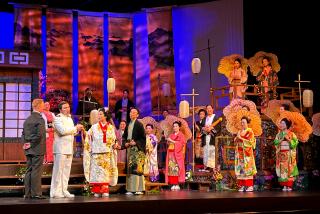Tibet bullied by China? Oh, contralto
- Share via
BEIJING — In a bid to show the world that it is peace-loving in its dealings with Tibet, Beijing will present a Tibetan-Chinese opera beginning Thursday as part of its Olympic spotlight on Chinese culture.
The “Princess Wencheng” opera tells the story of a 7th century Chinese princess who, driven by duty, friendship and personal sacrifice, acts as a bridge and civilizing influence on what is now Tibet.
Some of the more nuanced lessons from Chinese history may elude foreign audiences. But the show’s director is hopeful that audiences will take away the message that Tibet has always been part of China, which has had Tibet’s best interests at heart.
Just in case, Mandarin and English speakers can follow along with subtitles. There are none in Tibetan.
China came under sharp criticism from foreign governments and human rights groups in March when its communist government cracked down on Tibetan demonstrators.
“I believe if Princess Wencheng and [her Tibetan husband] King Songtsen Gampo knew about the March events, they would blame the rioters,” said Gao Mukun, the opera’s director, in an interview in the opera company’s wood-paneled meeting room. “I want to show that China is a big family that needs to have peace and harmony and oppose war.”
The Chinese government has long used art to deliver political messages, including its decision to expose President Nixon to the “Red Detachment of Women” ballet, with its themes of patriotism, national glory and military devotion, during his seminal visit to Beijing in 1972.
Gao knows a thing or two about the politics of culture, having survived the 1966-76 Cultural Revolution.
The then-Beijing opera star avoided a long stint in the countryside, a fate other artists suffered. To the contrary, he won the top male role in the revolutionary opera “Azalea Mountain,” commissioned by Mao’s wife, Gang of Four member Jiang Qing.
Gao said it was his idea alone to produce “Princess Wencheng” during the Olympics. That may be the case, analysts said, but it almost certainly went through serious vetting.
Senior leadership has taken enormous interest in the smallest of Olympic details. There were even reports that it was a Politburo member who nixed a 7-year-old’s appearance in the opening ceremony because she had crooked teeth.
All things Tibetan are particularly sensitive now because of the recent demonstrations. Moreover, President Hu Jintao has a personal interest in Tibet given his former tenure as the region’s Communist Party secretary.
The opera is scheduled to run for three days at the Mei Lanfang Theater in Beijing.
Though the Chinese version of the Princess Wencheng tale paints a picture of harmonious relations and Chinese altruism, Tibetan history tells a different story, said John Powers, an Asian studies professor at Australian National University.
The Chinese emperor married the princess off out of necessity, because the Tibetan king had just conquered nearly a third of China’s territory, Powers said. This strongly suggests that Tibet was not always part of China, he said.
Far from a sophisticated cultural ambassador, Princess Wencheng was 12 years old, by some accounts, when she moved to Tibet, and as the second of the Tibetan king’s four wives, probably had limited cultural influence on her husband or new homeland, although she is credited with helping introduce Buddhism.
“Basically the two versions tell a very different story,” Powers said. “The Chinese want to show the world that their version is the truth.”
Most ordinary Chinese don’t know much about Tibetan history and come to operas and other “minority performances” for the spectacle, said Dechen Pemba, an ethnic Tibetan living in London after being deported from China as part of the country’s pre-Games tightening of visa policy.
“They’re very selective with their history,” she said. “They always say China has sovereignty over Tibet, as shown by the princess story. They also want to show that minorities are part of a big happy family, all loyal to Beijing.”
Jia Zhigang, researcher for the Chinese National Academy of Arts, said China wasn’t trying to send a message by staging this production now. “This opera provides one more choice for Olympic audiences, with a focus on ethnic harmony,” he said. “It’s just a performance.”
Chinese communist leader Chou En-lai reportedly inspired the “Princess Wencheng” opera in a 1955 conversation shortly after the People’s Liberation Army marched into Tibet and a few years before Tibet’s spiritual leader, the Dalai Lama, fled to India.
But it wasn’t produced until 2005, to mark the 40th anniversary of the Tibetan Autonomous Region, as the province is called.
“Princess Wencheng,” a joint production of the China National Peking Opera Theater and the Tibetan Opera Troupe, attempts to meld two very different operatic forms. Tibetan opera has a roughly 600-year history, compared with the Beijing Opera’s 200 years.
“The union between our two peoples is now seen in the union of these two art forms,” Gao said.
Zhu Shaoyu, the opera’s composer, said the key to this artistic marriage is music. “Tibetan opera and Peking opera have totally different systems, language, instruments and styles,” he said.
“I have used many [musical] techniques to overcome these differences, and we succeeded.”
Ordinary audiences may find the two styles work together, said Jia, the researcher, “but for experts, it is not so smooth.”
Gao said people everywhere should perform the same bridge function that Princess Wencheng served in her day.
“If people have an incorrect understanding of this issue, I hope they can learn,” he said.
--
More to Read
Sign up for Essential California
The most important California stories and recommendations in your inbox every morning.
You may occasionally receive promotional content from the Los Angeles Times.













